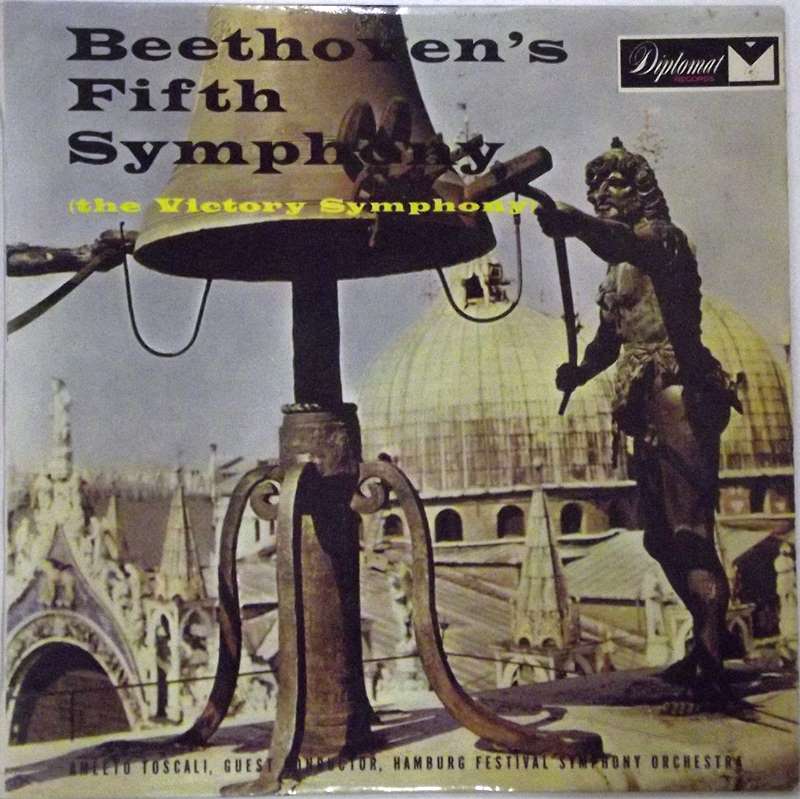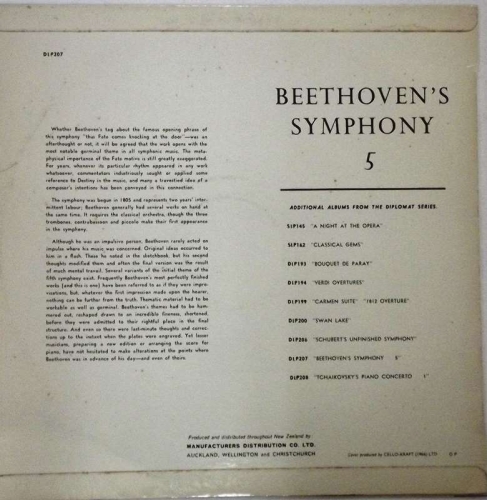

| Product Code: | DLP207 |
| Artist: | Beethoven* : Amleto Toscali, Hamburg Festival Symphony Orchestra* |
| Origin: | New Zealand |
| Label: | Diplomat |
| Format: | LP |
| Availability: | In Stock |
| Condition: |
Cover: VG+
Record: VG+
|
| Genre: | Classical U |
Good clean vinyl with a smart gloss flipback cover.
 Composer: Ludwig van Beethoven
Composer: Ludwig van Beethoven
© Richard Freed
Beethoven composed his Fifth Symphony between 1805 and 1808, from sketches made as early as 1800 but mostly in 1804; he conducted the first performance on December 22, 1808, at the Theater an der Wien in Vienna. The National Symphony Orchestra performed this work in its very first concert, on November 2, 1931, under Hans Kindler, and presented it last on September 9 and 10, 2004, Bruno Weil conducting. The score, dedicated to Prince Lobkowitz and Count Rasumovsky, calls for piccolo, 2 flutes, 2 oboes, 2 clarinets, 2 bassoons, contrabassoon, 2 horns, 2 trumpets, 2 trombones, timpani, and strings. Duration, 32 minutes. In his early 20th-century biography of Beethoven, Emil Ludwig referred to the Fifth Symphony as "the greatest portrait that Beethoven has given us of himself." This work stands not only as the very middle of Beethoven's cycle of symphonies, but in the broader sense, as the "central" work of the entire symphonic repertoire. It is the essence and epitome of the very term "symphony," the norm for the ages and the "big work" on the inaugural program of many an orchestra, as it was for the New York Philharmonic on December 7, 1842, for the National Symphony Orchestra 89 years later, and for the openings of countless new halls since then. The Fifth Symphony has been generally regarded as the quintessential work of its genre for nearly 200 years. Like more than a few such revered works, it was something largely unexpected and more than a little puzzling when it was first heard. The concert in which it was given its premiere at the end of 1808 was one of those jam-packed events, of several hours' duration, that seem to have been the norm for introducing Beethoven's new works in that decade. It was the occasion on which Beethoven made his last public appearance as soloist with an orchestra, in the newly composed Fantasia in C minor for piano, chorus and orchestra, and the first public performance of the Fourth Concerto. Also presented were the concert aria Ah perfido and several sections of the Mass in C major as well as at least one unaccompanied piano piece and the premieres of the Fifth and Sixth symphonies (whose numbering was reversed in the printed program). Of all these works, the Choral Fantasy may have been the most unusual in its layout and its mixture of performing forces, but the Fifth Symphony must have appeared the strangest in its substance. The Third Symphony (the Eroica), introduced nearly four years earlier, had revealed a new concept of the symphony in terms of depth, proportions and overall expressiveness. Beethoven then interrupted his work on his next two symphonies in 1806 to compose the unexpectedly lyrical Fourth, the only one of his symphonies composed, apparently, without any preliminary sketches. The Fifth, sketches for which date back as early as 1800, emerged at the end of 1808 as a work perhaps still more thoroughly dramatic than the Eroica--certainly more conspicuously tightknit and "organic," and perhaps even more specifically heroic. It is in any event one of the basic works by which we recognize Beethoven's intense admiration for and commitment to the heroic ideal. More than any other single work, it was to set the pattern of "victory through struggle" that would be effectively observed in dozens of well known symphonies from Beethoven's time to our own; but, despite the numerous works frankly modeled after it, it was to remain unique. One of those dozens of later symphonies was Tchaikovsky's Fourth. When that work was first performed, some 70 years after the premiere of Beethoven's Fifth, Tchaikovsky's junior colleague and former pupil Sergei Taneyev complained that it was obviously "program music" and as such was a "degradation of a noble form." Tchaikovsky replied that a program is "precisely what one would expect from a symphony, the most lyrical of musical forms," and he added, In my innocence, I thought the idea behind my symphony was so plain that everyone would grasp it, or at any rate its chief outlines, without the need of a written program. . . . I don't express any new thought, and haven't even tried to. The idea . . . is basically a reflection of Beethoven's Fifth--not the musical content, of course, but the central plan. Must I tell you that the Fifth not only has a program, but such an obvious one that everybody agrees about it? Tchaikovsky eventually did write out a detailed program for his Fourth Symphony, in a frequently quoted letter to his patron Nadezhda von Meck. Beethoven, however, said nothing about any philosophical or dramatic significance in his Fifth. The remark about its opening theme--"Thus Fate knocks on the door"--attributed to him by his early biographer Anton Schindler was one of Schindler's own concoctions; but that theme has been generally labeled a "Fate" motif, not only because of its striking impact at the outset but largely on the strength of its reappearance, in slightly altered form, in subsequent movements. (From our present-day vantage point, the more pertinent Tchaikovsky parallel in this respect would be the Russian master's own Fifth Symphony rather than his Fourth.) The work as a whole is cited as an expansion of a declaration which may be as apocryphal as the reference to Fate knocking on the door, but which certainly suits the work and its composer's state of mind at the time he wrote it. In this case Beethoven is said to have written when, after yielding to despair in the pathetic "Heiligenstadt Testament," he began to come to terms with his growing deafness, "I will seize Fate by the throat; it shall not wholly overcome me." This "Fate" motif, incidentally, may be seen as being related to the second half of the main theme of the first movement of the Eroica, a figure which itself hammers away in that earlier symphony as this one does in the Fifth. There are lyric passages, too, which serve to throw the drama into higher relief. The second movement, whose theme may be regarded as a variant of the "Fate" motif, is in a variation style as personal to Beethoven as the variation treatment in Haydn's slow movements was to that composer. J.W.N. Sullivan, in his study Beethoven: His Spiritual Development, described this Andante con moto as a mere resting-place, a temporary escape from the questions raised by the first movement. The scherzo, however, is a very different affair. Dreadful apprehension, defiance, a primitive surging energy, enter into this amazing picture of a tortured mind that has almost abandoned hope. That he should be able to make this material run so swiftly and cleanly is the most striking evidence Beethoven had given up to this time of his immense organizing power. In the scherzo the "Fate" motif, somewhat distorted but clearly recognizable, makes a most dramatic reappearance and constitutes a good deal of the movement's substance, but the most striking single feature here is the grotesque yet fleet-footed dance for the cellos and double basses ("like the gambols of an elephant," according to Berlioz), which serves as the movement's trio. In the mysterious and suspenseful transition to the finale, grotesquerie vanishes and the passage from darkness into light is achieved with stunning assertiveness. In the jubilant course of this triumphal movement there are again echoes of the "Fate" motif, more or less as in the scherzo, but these allusions are entirely entirely free of menace. There is, on a steadily rising level throughout this movement, a sense of liberation as well as exuberance, as Romain Rolland observed in his summing-up of "this intoxicating finale": "What is it else but the soul delivered, which, on its own beaten body, rises triumphant toward the light?" If we find Romain Rolland's language now rather dated, and smile at the indulgence it requires, we have to concede that that we are no better equipped now than he was a hundred years ago to describe such music in words. For the music itself, however, there is no question of indulgence and we need make no allowances: the Fifth has lost neither its power nor its pertinence over the years, and familiarity seems neither to diminish its self-renewing freshness nor threaten its central position in the hierarchy of the symphony.